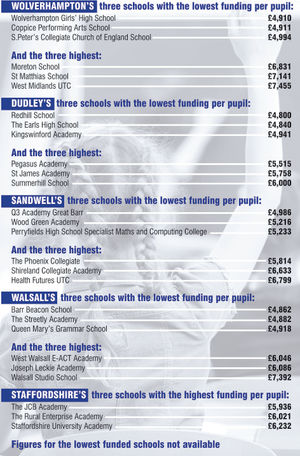Disparity in Black Country and Staffordshire school funding revealed
New Government data has revealed the gaps in schools funding that exist under the current highly controversial system.
The figures show big disparities in per-pupil funding at secondary schools, and partly explain why the formula is being phased out and replaced by a new framework that ministers insist is fairer.
Under the current system, pupils at Redhill School, Stourbridge, are each allocated £4,800 – the lowest funding in the Black Country and 20 per cent less than the £6,000 each that pupils at Kingswinford’s Summerhill School receive.
It is a similar story across the whole region, with each local authority area seeing a difference of between 20 and 28 per cent between the best and worst funded schools.
The current funding formula is made up of budgets set by local councils alongside cash from government grants, which is determined by factors including pupil numbers. Extra cash can be allocated for pupils with additional needs, and for those classed as living in deprivation.

A new national funding formula – first announced by the Government in 2016 – is set to come in, with all local authorities directed to follow it by 2021.
It aims to remove discrepancies in funding arising from budgets being allocated by local authorities, in a bid to ensure that all school budgets are set using the same criteria.
From next year the minimum per-pupil funding level will be set at £5,000 for secondary schools , in a move Education Secretary Gavin Williamson says will guarantee funding is directed towards the pupils who need it most.
Andrew Burns, executive principal at Ormiston Forge Academy and Ormiston NEW Academy in the Black Country, said the new system will be “far simpler and transparent” – and an improvement on the current “unfair” framework.
“Every child will get the same amount of money and that will be topped up with extra cash for deprivation and special needs,” he said.
“Local authorities will have an effect on that, so Sandwell, for example, will get more money than somewhere like Kent, due to there being more need in Sandwell.
“At the moment there is an average difference around the country of up to £500 per pupil. Sandwell is actually one of the lowest funded local authorities. As an example, we get £500 a year less per pupil than Stoke.
“The important thing is that the funding makes it to the right children.”
Politics
Mr Burns said that while the new system would make things better, party politics had played a role in some local authorities delaying bringing it in.
“Some of them are not moving to it with any great speed,” he said. “Part of that is undoubtedly down to Labour-run councils not wanting to bring in a Conservative policy”.
However, Mr Burns warned that the increased Government funding for schools over the next three years was only a “sticking plaster” that would not make up for years of under-funding.
The Government has pledged to invest an extra £7.1bn in schools in England over the next three years, including an increase of £2.6bn to the core schools budget in 2020-21.
Unions have warned of a schools funding crisis, saying there will be a shortfall of £2.5bn in the coming year.
The Education Policy Institute (EPI) think tank has claimed the new framework could direct extra cash towards more affluent schools which “risks widening the education attainment gap”.
Jon Andrews, deputy head of research at the EPI, said schools had seen “growing pressure” on budgets due to a real terms drop in per-pupil funding over the past decade.
He claimed that while the Government’s plans would reverse school funding cuts, per pupil funding in 2022-23 would be no higher in real terms than in 2009, adding: “The Government has vowed to ‘level up’ school funding, by increasing the minimum level of per pupil funding that primary and secondary schools receive.
“This approach will, however, disproportionately direct additional funding towards more affluent schools with the least challenging intakes.”




